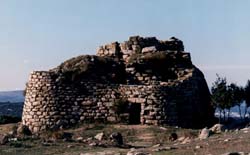| 14 | The Camillo Story |
The Sardinian Connection
As mentioned above, the island of Sardinia was to play an important role in the Dino Camillo family and here we will take a closer look at this fascinating island and the inhabitants that became, by marriage, an integral part of the Camillo family.
A
Brief History of Sardinia
In
order to understand the people of a region, it is useful to know a little
of their history. Sardinia is a very ancient land mass, perhaps the oldest
of all Italy, going back to the Cambrian period, 570 million years ago.
With the periodic fluctuation of the sea level, caused by the coming and
going of the periods of glaciation, the island of Sardinia had at times a
land link to the rest of Italy.
The
land-bridge that connected Sardinia to the main-land
During
these periods, beginning two million years ago, many animals crossed the
land bridge from Tuscany, through Elba and Corsica, then across the
Bonifacio Straits into Sardinia. Of course in the interglaciation periods,
Sardinia became an island once more. These animals, being cut off from any
possibility of refreshing their genetic patrimony, slowly evolved into
species quite different to their original ancestors. Curiously, the
tendency was to decrease in size, perhaps for lack of space and food and
we therefore find that the elephants in Sardinia (the climate was tropical
at the time) had shrunk in size to that of a dog !
In
the recent Pleistocene and in the more recent Olocene, between 10,000 and
20,000 years ago, the first man ventured across the same land bridge and
was similarly trapped on the island. Today, genetically, the Sardinians
are very different from all mainland populations and are in fact a breed
all of their own.
The
average stature of Sardinians is rather on the low side and perhaps the
same principles of the little elephants have applied, but more likely the
governing factor may have been the very rocky terrain that favours a lower
centre of gravity and therefore shorter bodies. In fact contrarily, the
flat African plains produced long legged and fast running natives (probably
to outrun the many man-eating animals there).

The
scant population that lived in Sardinia from 1800 B.C. to 200 B.C. was
known as the Nuragic people, who lived in stone dwellings and built the
round conical towers, probably for religious - astronomical rituals, that
are a characteristic feature of the Sardinian landscape. Their knowledge
for the manufacture of bronze artifacts, probably came from the Etruscans
on the neighbouring mainland, who most likely traded this know-how for the
raw materials that were plentiful on the island.
They
were mainly a pastoral people and the tradition and its very same, simple methods, have been maintained in Sardinia for over 3000 years,
right up to the present. It has only been over the past 10 to 15 years
that we have seen a certain amount of mechanisation. Even today, you can
still see peasant farmers travelling by donkey and up to just a few years
ago, you could occasionally witness the tilling of the land with an
ox-drawn, wooden plough!
An
interesting note, is the intact survival of a Nuragic tribe well into the
Roman times, since it lived well hidden in a wonderful "lost valley",
the Valley of Lanaittu. This can be seen today, still intact, without any
buildings, apart from the primitive ones. The two Nuragic villages were in
an enormous natural cavern, in a very inaccessible place, Monte Tiscali,
whose ceiling had caved in before their settlement, providing overhead
lighting and ventilation.
Sardinia
is rich in minerals, coal, silver, lead, zinc and iron and it wasn't long
before the word got around the Mediterranean and many people came from
afar to mine them. The Phoenicians, brave sailors and traders, made their
first settlements here around the 9th century B.C. in Tharros, Caralis
(Cagliari), Nova Sulcis, Turris Libyssonis (Porto Torres), Terranova
(Olbia) and slowly made their way inland. Then came the Cartheginians,
around the 6th century B.C., then the Greeks and finally came the Roman
conquest in 238 B.C.
Return to Menu of Camillo Story
l-camillo.com
Copyright L. Camillo 2000
